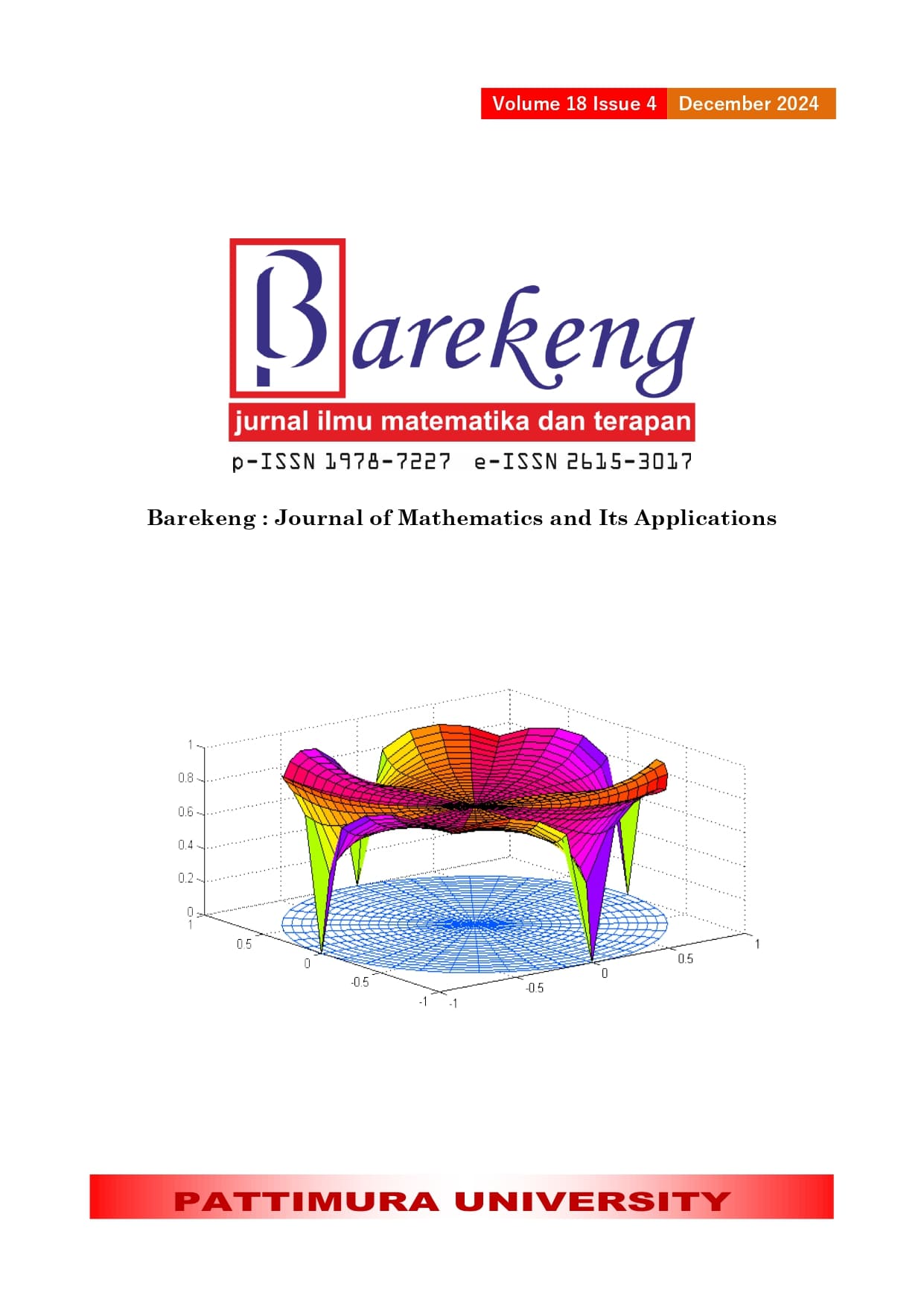DIFFERENCE EQUATION FOR AUSTRALIAN SHEEP BLOWFLIES GROWTH
Abstract
The population of Australian sheep blowflies, Lucilia cuprina, in Australia is of concern to many researchers because it causes several problems. These problems occur in the sheep industry where there is a term "flystrike" in the industry. Flystrike is a fly attack on sheep that causes myiasis on the sheep's skin, affecting the quality and quantity of wool. In the worst cases, the sheep may die if not treated. This issue has attracted researcher to conduct a population control study of fly growth to suppress flystrike in the Australian sheep industry. In this paper, fly growth will be approached using a difference equation to better represent the industry’s situation. This equation will be analyzed using its approximate solution that is obtained through linearization of perturbation method, Cardano’s formula, and Galois solution’s method. By studying fly growth, Australian sheep farmers may find it easier to handle and prevent fly infestations using the solution.
Downloads
References
B. J. Winkel, “Parameter Estimates in Differential Equation Models for Population Growth,” PRIMUS Probl. Resour. Issues Math. Undergrad. Stud., vol. 21, no. 2, pp. 101–129, 2011.
Anggreini, “Model Matriks Leslie dengan Strategi Pemanenan pada Kelompok Umur Termuda pada Angka Kesuburan dan Harapan Hidup Populasi Domba Betina,” Fourier, vol. 7, no. 1, pp. 23–34, 2018.
A. J. Nicholson, “The selft-adjustment of populations to change,” Cold Spring Harb. Symp. Quant. Biol., vol. 22, pp. 153–172, 1957.
R. May, Theoretical Ecology: Principles and Applications, 2nd ed. Oxford: Blackwell Scientific Publications, 1981.
B. Barnes and G. R. Fulford, MATHEMATICAL MODELLING WITH CASE STUDIES Using MapleTM and MATLAB®, 3rd ed. LLC. Florida US: Taylor & Francis Group, 2015.
J. L. Capinera, Encyclopedia of Entomology. Dordrecht: Springer, 2008.
K. R. Norris, The Ecology of Sheep Blowflies in Australia, In: Keast, A., Crocker, R. L., Christian, C. S. (eds) Biogeography and Ecology in Australia, Monographiae Biologicae. Dordrecht: Springer, 1959.
A. F. Colvin, I. Reeve, L. P. Kahn, L. J. Thompson, B. J. Horton, and S. W. Walkden-Brown, “Australian surveys on incidence and control of blowfly strike in sheep between 2003 and 2019 reveal increased use of breeding for resistance, treatment with preventative chemicals and pain relief around mulesing,” Vet. Parasitol. Reg. Stud. Reports, vol. 31, 2022.
I. Rashkovsky and M. Margaliot, “Nicholson’s blowflies revisited: A fuzzy modeling approach,” Fuzzy Sets Syst., vol. 158, pp. 1083–1096, 2007.
G. E. Hutchinson, “CIRCULAR CAUSAL SYSTEMS IN ECOLOGY,” Ann. N. Y. Acad. Sci., vol. 50, no. 4, pp. 221–246, 1948.
A. J. Nicholson, “An outline of the dynamics of animal populations,” Aust. J. Zool., vol. 2, no. 1, pp. 9–65, 1954.
A. Bouakkaz and R. Khemis, “Positive periodic solutions for revisited Nicholson’s blowflies equation with iterative harvesting term,” J. Math. Anal. Appl., vol. 494, no. 2, 2021.
L. Li, X. Ding, and W. Fan, “Almost periodic stability on a delay Nicholson’s blowflies equation,” J. Exp. Theor. Artif. Intell., pp. 1–14, 2023.
Y. Bai and Y. Li, “Almost periodic positive solutions of two generalized Nicholson’s blowflies equations with iterative term,” Electron. Res. Arch., vol. 32, no. 5, pp. 3230–3240, 2024.
Z. Wu and A. Muhammadhaji, “Dynamics in a Competitive Nicholson’s Blowflies Model with Continuous Time Delays,” Symmetry (Basel)., 2023.
W. Wang, L. Wang, and W. Chen, “Stochastic Nicholson’s blowflies delayed differential equations,” Appl. Math. Lett., vol. 87, pp. 20–26, 2019.
R. Khemis, “Existence, uniqueness and stability of positive periodic solutions for an iterative Nicholson’s blowflies equation,” J. Appl. Math. Comput., vol. 69, pp. 1903–1916, 2023.
C.-S. Liu and C.-W. Chang, “A novel perturbation method to approximate the solution of nonlinear ordinary differential equation after being linearized to the Mathieu equation,” Mech. Syst. Signal Process., vol. 178, 2022.
T. Canor, L. Caracoglia, and V. Denoël, “Perturbation methods in evolutionary spectral analysis for linear dynamics and equivalent statistical linearization,” Probabilistic Eng. Mech., vol. 46, pp. 1–17, 2016.
W. M. Faucette, “A geometric interpretation of the solution of the general quartic polynomial,” Am. Math. Mon., vol. 103, no. 1, pp. 51–57, 1996.
E. Artin, Galois Theory. Notre Dame: Uniersity of Notre Dame Press, 1944.
Copyright (c) 2024 J I Gisbtarani, H Setiyaningsih, M N Huda, Solikhatun Solikhatun

This work is licensed under a Creative Commons Attribution-ShareAlike 4.0 International License.
Authors who publish with this Journal agree to the following terms:
- Author retain copyright and grant the journal right of first publication with the work simultaneously licensed under a creative commons attribution license that allow others to share the work within an acknowledgement of the work’s authorship and initial publication of this journal.
- Authors are able to enter into separate, additional contractual arrangement for the non-exclusive distribution of the journal’s published version of the work (e.g. acknowledgement of its initial publication in this journal).
- Authors are permitted and encouraged to post their work online (e.g. in institutional repositories or on their websites) prior to and during the submission process, as it can lead to productive exchanges, as well as earlier and greater citation of published works.






1.gif)



